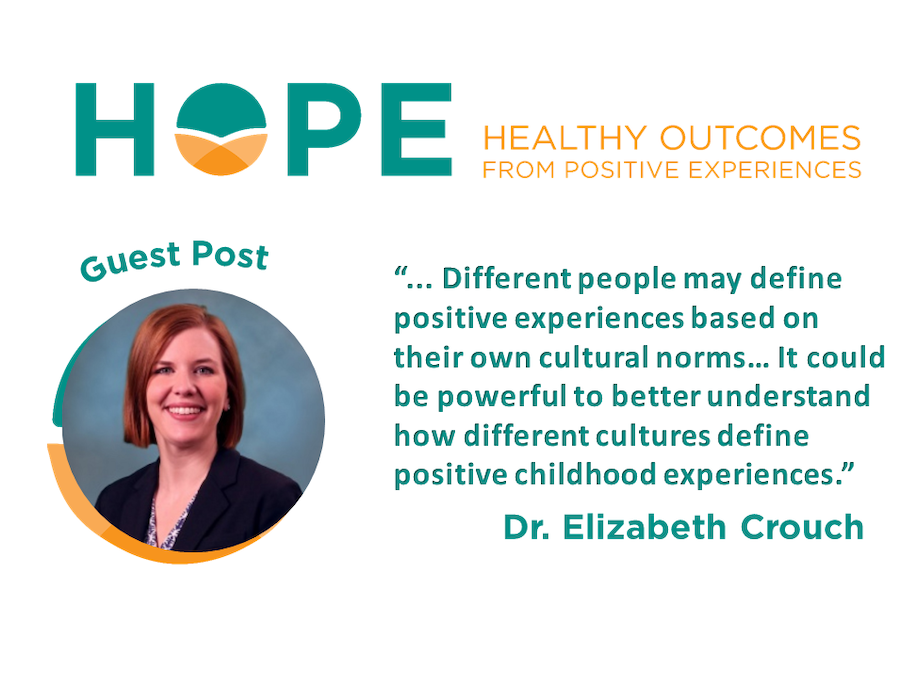
Key takeaways
- This interview features Elizabeth Couch, PhD, associate professor of health services policy and management and Co-Director of the Rural Health Research Center at the University of South Carolina.
- A research study published in 2020 found rural children were more likely than urban peers to volunteer in their communities and have mentors outside the home, highlighting areas of resilience that can guide program development.
- The study also found that Hispanic and Black children were less likely to report having mentors and more likely to live in unsafe, unsupportive neighborhoods, with lower overall positive childhood experiences reported.
- Cultural differences in defining positive experiences must be better understood to strengthen resilience research.
This interview summary was created with the assistance of artificial intelligence (AI) and reviewed by the HOPE National Resource Center staff before publication. No other parts of the blog post were generated by AI. Found an error? Let us know.
How people define positive childhood experiences based on different cultural norms
All children need positive childhood experiences (PCEs). The HOPE National Resource Center believes that every child in each community should have access to the key types of PCEs that we call the Four Building Blocks of HOPE: safe and supportive relationships that are critical for children to develop into healthy, resilient adults; safe, stable, equitable environments to live, learn, and play; opportunities for social and civic engagement to develop a sense of belonging; and opportunities for emotional growth.
This blog features an interview with Elizabeth Couch, PhD, associate professor of health services policy and management and Co-Director of the Rural Health Research Center at the University of South Carolina.
Please introduce yourself and your work to our blog readers.
I am a health policy researcher whose work examines health disparities among rural and other vulnerable populations, with a primary focus on children. I am an assistant professor in the Arnold School of Public Health’s Department of Health Services Policy and Management at the University of South Carolina and Deputy Director of the Rural and Minority Health Research Center. My research has led to numerous leadership experiences: co-leading a federally funded research center, the Rural and Minority Health Research Center; serving as a board member of a national organization, the National Rural Health Association; and serving as principal investigator focused on rural health and child health. I am also the principal investigator for the evaluation of the Maternal Infant Early Childhood Home Visiting Programs in South Carolina. With this grant, I work closely with community and state partners, such as The Children’s Trust of South Carolina, in the prevention of child abuse and neglect.
What about the HOPE framework and positive childhood experiences (PCEs) interested you?
Childhood experiences, both positive and adverse, can affect the healthy development of children into adulthood. I had been writing on Adverse Childhood Experiences (ACEs) for a few years when I attended the 2018 Montana Summer Institute. Dr. [Robert] Sege was the keynote speaker talking about the other side of the coin: positive childhood experiences and how these could be leveraged to prevent, moderate, or mitigate ACEs. This inspired me to begin to quantitatively examine the prevalence of PCEs.
[We] found that rural children were more likely than urban children to volunteer in their community, school, or church, a measure of an opportunity for constructive social engagement. Rural children were also more likely to have a mentor outside of their home (school, neighborhood, or community), a measure of being in nurturing, supportive relationships. These findings provide information for stakeholders and program developers on what is happening in rural areas, and what may still need to be done. -Elizabeth Crouch, PhD
You recently published research studying racial/ethnic and rural-urban differences in PCEs. What motivated the rural-urban differences study? What were the results?
Rural health research is of great importance, as 57 million people reside in rural America, yet rural residents suffer significant disadvantage in access to health care, with corresponding higher mortality risk and lower quality of life. Therefore, research that illuminates disparities and identifies key points of intervention that can address these disadvantages is critical.
Rural children have higher rates of ACEs, such as economic insecurity, an ACE measured in the National Survey of Children’s Health, but no research had yet examined the prevalence of PCEs in rural children, which is critically important. This became even more apparent to me when I was an invited speaker for the National Rural Health Advisory Committee Meeting in 2018, addressing adverse childhood experiences in rural areas. So, in 2020, using the National Survey of Children’s Health, we published a study examining rural urban differences in PCEs and found that rural children were more likely than urban children to volunteer in their community, school, or church, a measure of an opportunity for constructive social engagement. Rural children were also more likely to have a mentor outside of their home (school, neighborhood, or community), a measure of being in nurturing, supportive relationships. These findings provide information for stakeholders and program developers on what is happening in rural areas, and what may still need to be done.
What motivated the study racial/ethnic differences study? What were the results?
Racism affects the social determinants of health and the four categories in the HOPE framework. We found that Hispanic and Non-Hispanic Black children were less likely to report having a mentor for advice or guidance. They also self-reported higher rates of living in unsafe and unsupportive neighborhoods and lower rates of experiencing three or more PCEs as they were defined by the NSCH.
However, this study is limited by the data available in the National Survey of Children’s Health, and how ACEs and PCEs are measured in that dataset. It does not measure the domains of PCEs and ACEs in a variety of cultures, so these results are limited by how the NSCH defined positive experiences. Future work should address this, perhaps by community based participatory research.
It could be powerful to better understand how different cultures define positive childhood experiences so that, moving forward, the field of resilience is informed as to how to best support children from a variety of races and cultures. -Elizabeth Crouch, PhD
Can you speak to the implications of these studies moving forward?
The implications of these studies are limited by how different people may define positive experiences based on their own cultural norms, as these findings use one method of quantifying positive experiences. It could be powerful to better understand how different cultures define PCEs so that, moving forward, the field of resilience is informed as to how to best support children from a variety of races and cultures.
However, generally, these findings have implications for more neighborhood-focused and community-building initiatives, as well as family-centered programs, which focus on expanding [access to] PCEs in schools, neighborhoods, and communities. On a national scale, policy-oriented approaches to address housing and income inequities must be enacted to further the provision of PCEs among BIPOC families and communities.
What future research projects on PCEs do you have planned? Are there plans to disaggregate the racial/ethnic data (given the broadness of the current racial/ethnic categories)?
Yes! I am currently funded by the Federal Office of Rural Health Policy to examine rural urban differences in ACEs and PCEs. Part of this work will be examining within rural racial-ethnic differences in the prevalence of ACEs and PCEs. Race and place often intersect, with the majority of growth in rural populations among BIPOC children. Rural children are frequently treated homogenously and racial-ethnic differences within rural populations have been understudied.
The interview was edited for brevity and clarity.


